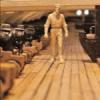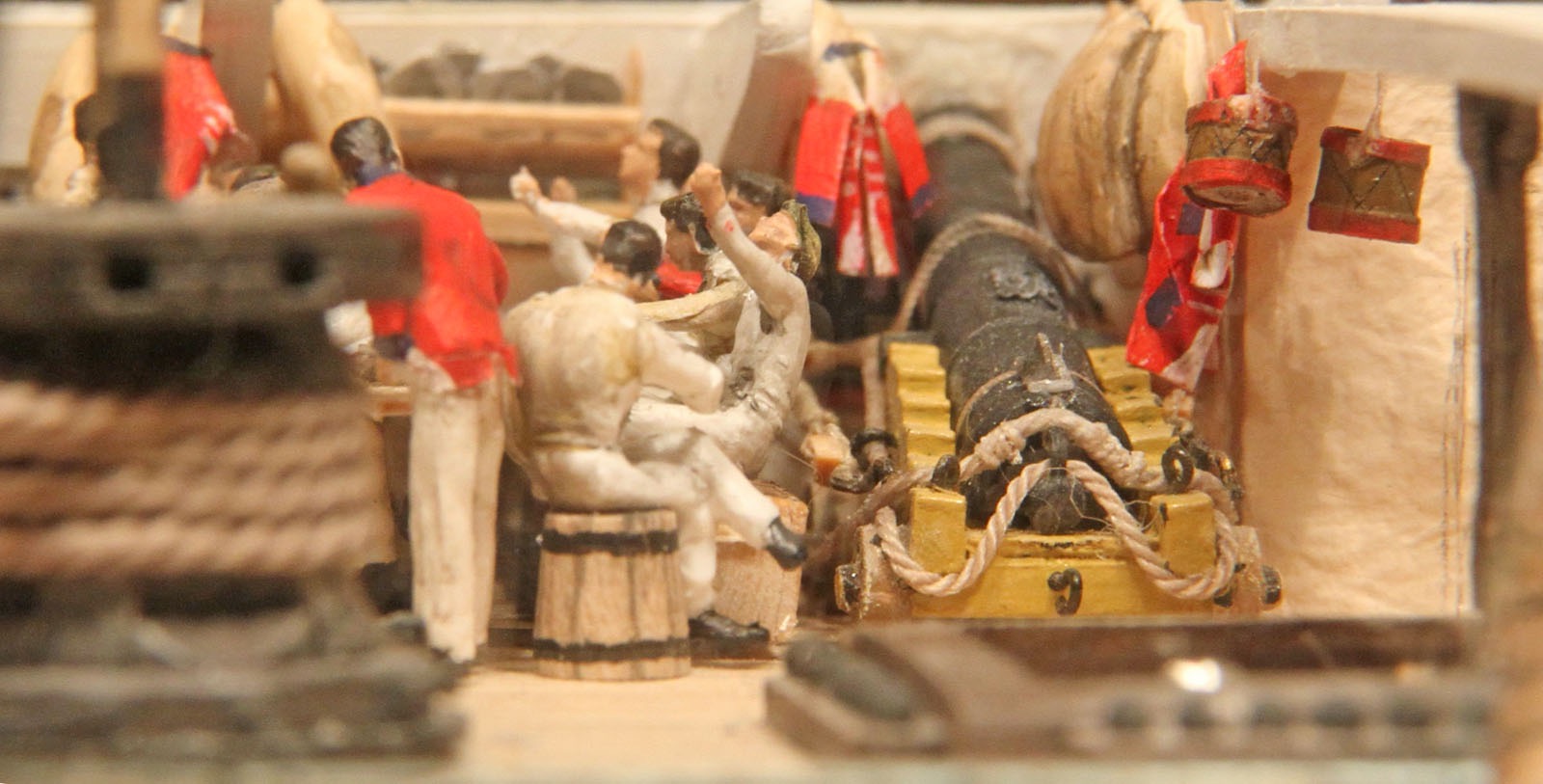-
Posts
2,416 -
Joined
-
Last visited
Content Type
Profiles
Forums
Gallery
Events
Everything posted by dafi
-

ancre LE BONHOMME RICHARD by Jeronimo - FINISHED
dafi replied to Jeronimo's topic in - Build logs for subjects built 1751 - 1800
Karl, the usual stunning and wonderful quality! Daniel- 662 replies
-
- bonhomme richard
- frigate
-
(and 1 more)
Tagged with:
-
Hy Verne, all obstacles, means ladders, stanchions, guns and other equipment had to be cleared before using the capstan. Hatches within the spars radius had to be closed. I do not know the american systems, bit the english had the large companionways made in two halves to make moving "easier" and had jacks to lift the decks beams to remove the stanchions. The french appearently had iron stanchions on hinges, which made disassembly easier. See here: #136 #146 #150 #156 Cheers, Daniel
- 135 replies
-
- Constitution
- Revell
-
(and 1 more)
Tagged with:
-
Hy modeltec, can you explain further or show pictures? XXXDAn
-
My best one only had about 500 pieces - but all of equal shape ... .. what a hell. My actual one has about 2.500 and is threedimensional - Vic-Vic-Hourray ;-) Daniel
- 1,038 replies
-
- King of the Mississippi
- Artesania Latina
-
(and 1 more)
Tagged with:
-
Finally worked my way through - wonderful look and feel :-) :-) :-) Keep on going! DAniel PS: Please do not scare the non native english speakers: I read procastration in n# 254 ... #254
- 389 replies
-
- supply
- caldercraft
-
(and 1 more)
Tagged with:
-

Mercury by DSiemens - FINISHED - BOTTLE
dafi replied to DSiemens's topic in - Build logs for subjects built 1801 - 1850
Lovely work!!! XXXDAn -
Lovely :-) ... if one is allowed to say this about a man o´war ;-) XXXDan
- 1,279 replies
-
- agamemnon
- caldercraft
-
(and 1 more)
Tagged with:
-
Now THAT will be a great party :-) Looking forward to see you all! DAniel
- 33 replies
-
- trinkstein
- frigate
-
(and 2 more)
Tagged with:
-
Hy Bob, it means "Trinking Stone", pure coincidence or more, non lo so* ... ;-) XXXDAn *I do not know
- 33 replies
-
- trinkstein
- frigate
-
(and 2 more)
Tagged with:
-
No more cheating attempts!!! No more cheating attempts!!! No more cheating attempts!!! No more cheating attempts!!! No more cheating attempts!!! No more cheating attempts!!! No more cheating attempts!!! No more cheating attempts!!! No more cheating attempts!!! No more cheating attempts!!! No more cheating attempts!!! No more cheating attempts!!! No more cheating attempts!!! No more cheating attempts!!! No more cheating attempts!!! No more cheating attempts!!! No more cheating attempts!!! No more cheating attempts!!! No more cheating attempts!!! No more cheating attempts!!! No more cheating attempts!!! No more cheating attempts!!! No more cheating attempts!!! No more cheating attempts!!! No more cheating attempts!!! No more cheating attempts!!! No more cheating attempts!!! No more cheating attempts!!! No more cheating attempts!!! No more cheating attempts!!! No more cheating attempts!!! No more cheating attempts!!! No more cheating attempts!!! No more cheating attempts!!! No more cheating attempts!!! No more cheating attempts!!! No more cheating attempts!!! No more cheating attempts!!! No more cheating attempts!!! No more cheating attempts!!! No more cheating attempts!!! No more cheating attempts!!! No more cheating attempts!!! No more cheating attempts!!! No more cheating attempts!!! No more cheating attempts!!! No more cheating attempts!!! No more cheating attempts!!! No more cheating attempts!!! No more cheating attempts!!! No more cheating attempts!!! No more cheating attempts!!! No more cheating attempts!!! No more cheating attempts!!! No more cheating attempts!!! No more cheating attempts!!! No more cheating attempts!!! No more cheating attempts!!! No more cheating attempts!!! No more cheating attempts!!! No more cheating attempts!!! No more cheating attempts!!! No more cheating attempts!!! No more cheating attempts!!! No more cheating attempts!!! No more cheating attempts!!! No more cheating attempts!!! No more cheating attempts!!! No more cheating attempts!!! No more cheating attempts!!! No more cheating attempts!!! No more cheating attempts!!! No more cheating attempts!!! No more cheating attempts!!! No more cheating attempts!!! No more cheating attempts!!! No more cheating attempts!!! No more cheating attempts!!! No more cheating attempts!!! No more cheating attempts!!! No more cheating attempts!!! No more cheating attempts!!! No more cheating attempts!!! No more cheating attempts!!! No more cheating attempts!!! No more cheating attempts!!! No more cheating attempts!!! No more cheating attempts!!! No more cheating attempts!!! No more cheating attempts!!! No more cheating attempts!!! No more cheating attempts!!! No more cheating attempts!!! No more cheating attempts!!! No more cheating attempts!!! No more cheating attempts!!! No more cheating attempts!!! No more cheating attempts!!! No more cheating attempts!!! No more cheating attempts!!! XXXDAn
-
Somewhere, somehow, sometimes I was wondering what I was doing ... ... and tried to remember, how things should look like, took some Evergreen, drilled some blocks, took 2 of my etch parts hooks (ATTENTION: Product placement), took some line, and after some hooks and turns ... ... that easy, so easy, so lessens learned: No more cheating attempts!!! (Message to myself: Write this down a 100 times to never forget again) So produced new blocks, punched some holes with the scriber on the 1 x 2 mm rod for the double blocks ... ... and on the 1 x 1 mm rod for the single blocks ... ... drilled with 0,5 mm ... ... and roughened the surface with a abrasive fleece. While cutting to length I used the scalpel to round the surface and out came an amount of itzy-bitzy-teeny-wheeny extra small blocks. Instead of painting I remembered tinting, a trick I once used successful while my studies on polyamide spheres: Tinting powder for synthetic fiber. But does this work for polystyrene? So the powder with vinegar and the parts into the pot and boil well and long :-) The toughest was to find the itzy-bitzy-teeny-wheeny extra small blocks in this mess in between the remains of undissolved color powder ... ... and it really worked! Not as well as I thought it would, but well enough for my needs. On the bigger parts one can see how much the color was absorbed and on the smaller ones particles of the powder even gave darker spots. Fixed the drill upside down ... ... used it to hold the block, knotted a thread onto one of my blackened hooks and attached it with some CA onto the block. Then knotted the backside and fixed all well with CA. The single block was done accordingly, just one side of the thread was left long ... ... to serve as lanyard, the ensemble put to length and secured with CA. Then the lanyard was wound round on the serving machine, checked ... ... and fits :-) A tad too short for this place, but this one will fit aft, where there is difference in lengths because of the curve of the hull. :-) Cheers, dafi
-
-fail-fail-fail- Was waiting already but nobody mentioned so far the missing side tackles on the guns ;-) But lazy dafi was trying to avoid work and was looking for easy-easy-easy way of cheating: casting he believed would be the easy option, making two halves and glueing them together in the required length ... ... 30 times lashed and 6 times in position ... ... lazy bastard ... So made very fastily blocks out of Evergreen rods ... ... went fast, drilled with 0,5 mm after setting a centre punch, fastily drilled ... ... and cut to length on a double sided tape. Small tail in the end ... ... some wire rope into the blocks ... ... and we got some cute sado-maso-killer-sperms :-) Happily made some wire lashings around ... ... did the castings ... ... and cried my eyes out as the resin needed for those tiny bits was pure waste ... ... and the parts too small and flimsy for mass production ... ... and on top of it the cleaning of the parts ... ... then realised that I need to paint them ... ... and the looks were not what i had in mind ... ... so got out the big chopper and reduced some parts ... ... to fit a nice fresh meal for the poor little sailors, sittings for weeks already in front of their empty plates ... ... and the rest ... ... went into Tar Jack´s box of the dead hallows, where all discarded parts end up. And so much for the wasted brainwaves, material and time to make it easy and fast ?!? And then I realised, how easy it could have been ... ... more soon. XXXDAn
-
And one more thing ... ;-) I do believe it was not sliding the anchor into the hole in the netting ... ... it was much more opening two ropes that were holding the hetting, swinging the netting back, handling the anchor without obstruction and putting the netting back. Also, this was an anchor, that was not in constant use. Love and peace, Daniel
-
Thank you Kevin, but I do strongly think, that dealing with the netting was the smallest task in the whole process ... :-) XXXDAn
-
Hy Popeye, thank you, and your guess is hot - these are mere preliminary guides just to see where the shrouds are situated. Have a good time, Daniel
-
So, finally some more easy tinkering was done. Anchors and hammock crane interaction :-). XXXDAn
-
Brilliant and outstanding as always :-) XXXDAn
- 241 replies
-
- royal caroline
- yacht
-
(and 1 more)
Tagged with:
-
Kay, you are spoiling us :-) XXXDAn
About us
Modelshipworld - Advancing Ship Modeling through Research
SSL Secured
Your security is important for us so this Website is SSL-Secured
NRG Mailing Address
Nautical Research Guild
237 South Lincoln Street
Westmont IL, 60559-1917
Model Ship World ® and the MSW logo are Registered Trademarks, and belong to the Nautical Research Guild (United States Patent and Trademark Office: No. 6,929,264 & No. 6,929,274, registered Dec. 20, 2022)
Helpful Links
About the NRG
If you enjoy building ship models that are historically accurate as well as beautiful, then The Nautical Research Guild (NRG) is just right for you.
The Guild is a non-profit educational organization whose mission is to “Advance Ship Modeling Through Research”. We provide support to our members in their efforts to raise the quality of their model ships.
The Nautical Research Guild has published our world-renowned quarterly magazine, The Nautical Research Journal, since 1955. The pages of the Journal are full of articles by accomplished ship modelers who show you how they create those exquisite details on their models, and by maritime historians who show you the correct details to build. The Journal is available in both print and digital editions. Go to the NRG web site (www.thenrg.org) to download a complimentary digital copy of the Journal. The NRG also publishes plan sets, books and compilations of back issues of the Journal and the former Ships in Scale and Model Ship Builder magazines.


